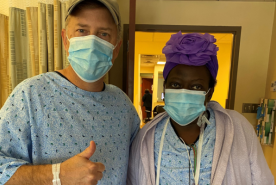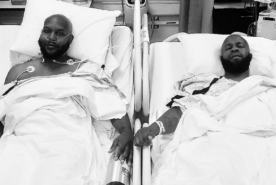Last Updated: March 15, 2024
Medically reviewed by NKF Patient Education Team
About Kidney Transplant
When your kidneys fail, treatment is needed to replace the work your own kidneys can no longer do. There are two types of treatment for kidney failure: dialysis or transplant.
When you get a kidney transplant, a healthy kidney is placed inside your body to do the work your own kidneys can no longer do. On average, a kidney transplant from a living donor lasts about 15 to 20 years, and a kidney from a deceased donor lasts 8 to 12 years. Some will last longer; others will last less.
Today, most people get a kidney transplant after being on dialysis for some amount of time, but that is not the only option. Getting a transplant before you need to start dialysis is called a preemptive transplant. Research shows that a preemptive or early transplant, with little or no time spent on dialysis, can lead to better long-term health. It may also allow you to keep working and have a better quality of life.
If your doctor has told you that your kidney disease is getting worse or that you are in a later stage of kidney disease, called Stage 3B, Stage 4, or Stage 5, it could be a good time to talk about kidney transplant.
Types: Living and Deceased
There are two types of kidney transplants: a deceased donor kidney transplant and a living donor kidney transplant. A deceased donor kidney comes from someone has died and made the decision to become an organ donor. A kidney from a living donor is from someone who is living, has two healthy kidneys, and chooses to donate one to someone in need. A living donor can be someone you know, like a family member or friend, but they do not need to be related to you.
The first step to getting a deceased or living donor kidney is to have an evaluation at a transplant center. In most cases, a potential living donor can be evaluated at the same time as the recipient, who is the person with kidney disease who needs a kidney.
Benefits of kidney transplant
Studies show that people with kidney transplants live longer than those who stay on dialysis. A successful kidney transplant may also allow you the freedom to live the kind of life you were living before you got kidney disease or started dialysis, including work, travel, and more time to spend with friends and family.
For many patients, there are fewer limits on what you can eat and drink, though you should follow a heart-healthy diet and maintain a healthy weight to help your new kidney last. Your health and energy should also improve.
Risks of kidney transplant
Having a kidney transplant does not “cure” kidney disease. There are also risks, including the risks of surgery. After the transplant, you will need to take anti-rejection medicines, also called immunosuppressants, for as long as your new kidney is working, which can have side effects. You will have a higher risk for infections and certain types of cancer.
Although most transplants are successful and last for many years, how long they last can vary from one person to the next. Depending on your age, many people will need more than one kidney transplant during a lifetime.
Who can get a kidney transplant
In general, kidney patients of all ages can be considered for transplant. Some transplant centers have an upper age limit, while others don’t have any age limit. Every person will complete a full medical and psychosocial evaluation at a transplant center to make sure they are a candidate for transplant. Candidates for transplant need to be healthy enough for the surgery and prepared to take care of the new kidney, including taking medications every day. In many cases, people who are older or have other health conditions like diabetes can still have successful kidney transplants.
Remember – being put on the waitlist is not automatic. If you are interested in getting a kidney transplant, you must go to a transplant center for an evaluation.
Kidney transplant surgery: how it works
The operation to place a new kidney takes about 3-4 hours. The donated kidney is placed into your lower abdomen (belly area), where it’s easiest to connect it to your important blood vessels and bladder. You may be surprised to learn that your own kidneys generally aren’t taken out when you get a transplant. The surgeon leaves them where they are unless there is a medical reason to remove them.
You'll be sore at first, but your transplant team will encourage you to stand up or even take a little walk the day of your surgery, depending on how you're feeling. You'll be able to go home within a couple of days. You will have lots of appointments at the transplant center for the first weeks after the surgery. Over time, if you and your new kidney are doing well, you will be able to return to your regular kidney doctor and have fewer appointments. You will need to take medications every day after a kidney transplant.
Where to start
The first step to getting a transplant is an evaluation at a transplant center. Even if you have a living donor who wants to donate a kidney to you, you still need to have an evaluation and get approved for the transplant waitlist. You can ask your healthcare provider to refer you to a transplant center for an evaluation, or you can contact a transplant center on your own. Any kidney patient can ask for an evaluation, even without a referral from their doctor, which is called a self-referral.
Questions for your healthcare team
- Is my kidney disease getting worse? Can you explain my labs?
- When will we talk about my treatment choices, including kidney transplant?
- Do you think kidney transplant could be a good option for me? What about living donation?
- Can you tell me more about life on dialysis vs. life with a transplant, based on my health?
- Can you please refer me for a kidney transplant evaluation?
- Share what a good or “normal” life looks like to you – what do you care about? What is most important to you? This can help you make shared decisions with your doctor about your treatment.
Remember – you are not placed on the waitlist automatically. You must do an evaluation at a transplant center to receive a kidney transplant.
















